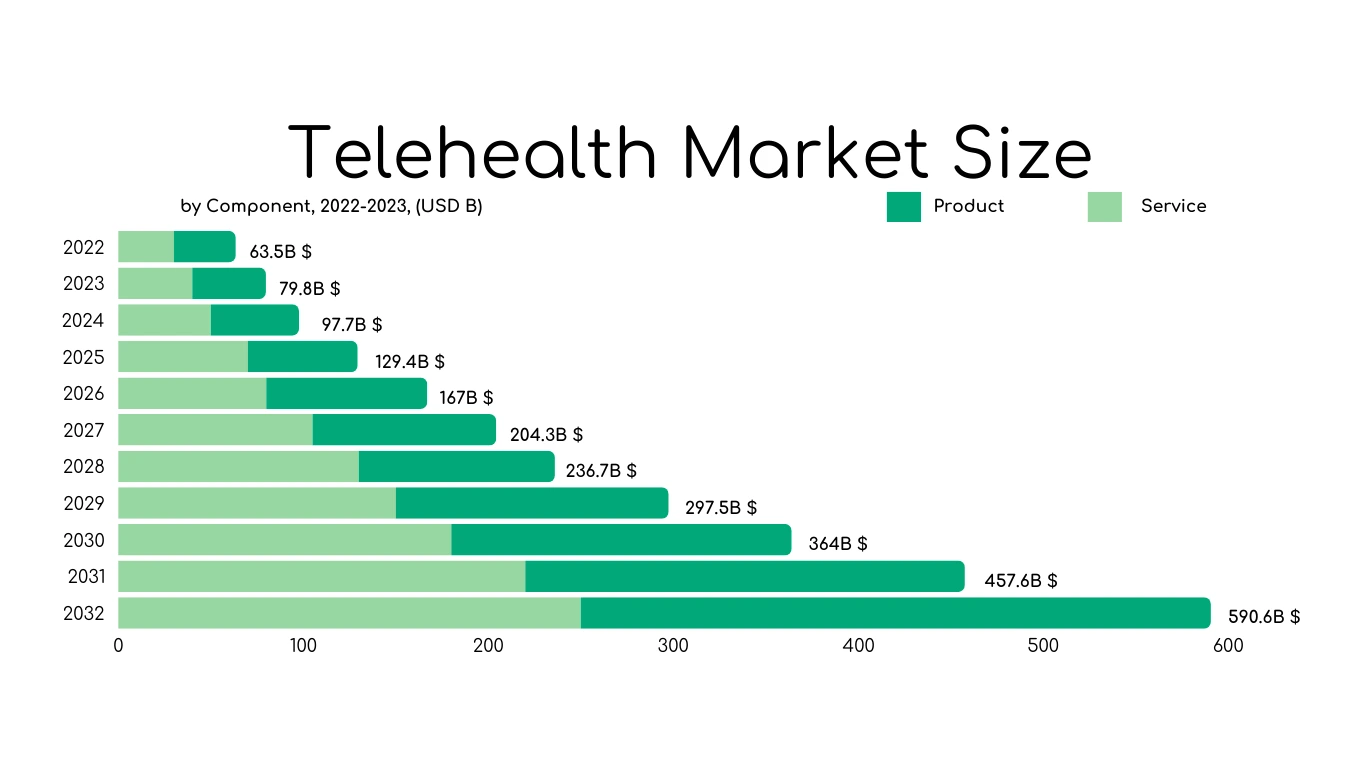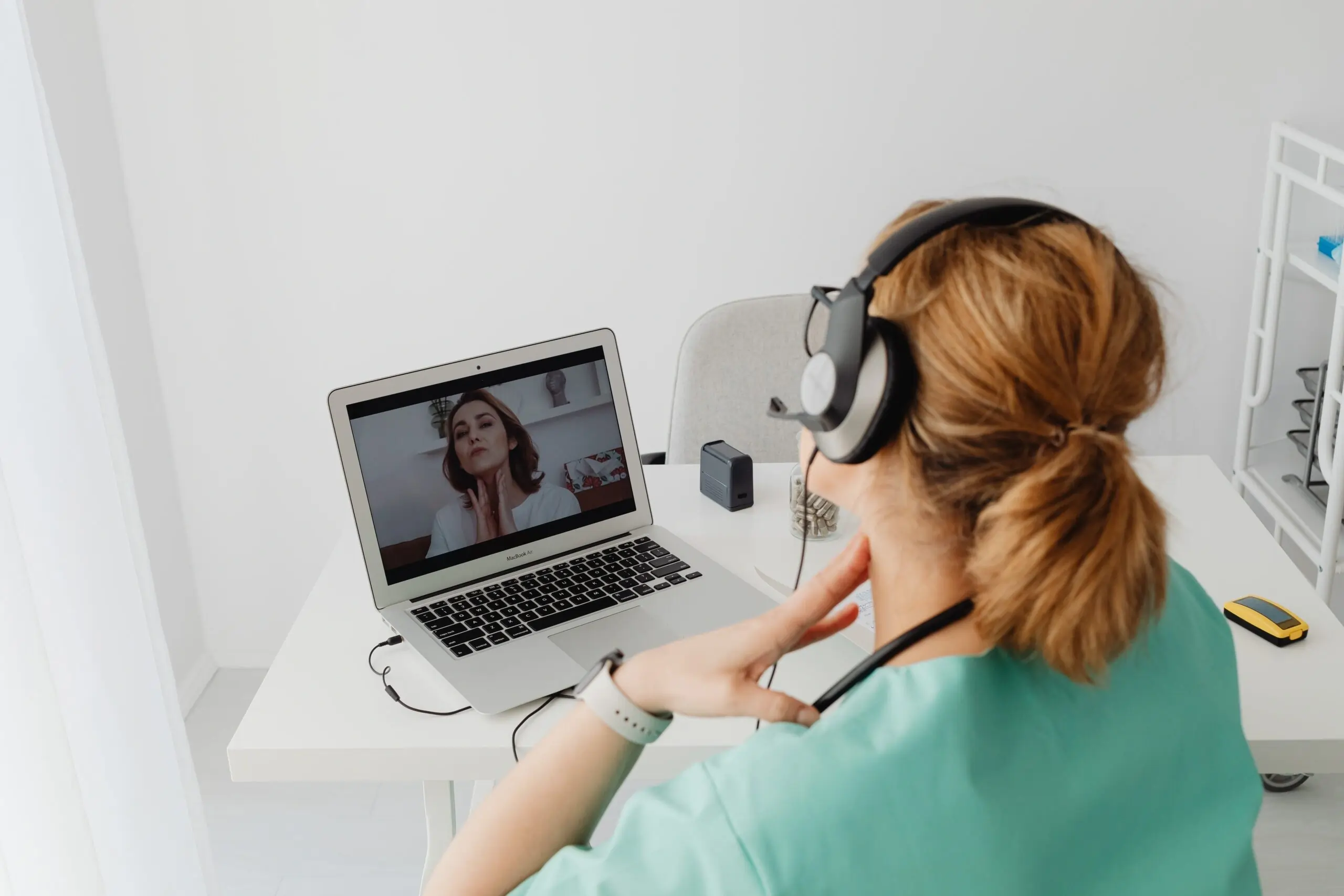With the growing demand for telemedicine services, we see significant demand for telehealth apps that can provide these services and connect doctors with patients. In this guide, we will closely examine the 5 top features modern telehealth apps should have to meet the conditions of the telemedicine market.

Telehealth Market Size (according to study source)
Secure login and authentication
Before you develop an app for patients to manage their appointments or use their health records, it’s crucial to ensure that such sensitive data is secured by two-factor authentication and data encryption. Besides these basic security features, robust telehealth applications often use role-based access control (RBAC), which allows for setting up access capabilities for different levels of users. Authentication security measures are also obligatory for HIPAA compliance.
As part of HIPAA-compliant products, you should also include Business Associate Agreements (BAAs) with third-party providers, which are contracts between telehealth providers and external services. The purpose of BAAs is to ensure that all business associates safeguard the security and privacy of PHI (Protected Health Information). Such agreements are unavoidable for cloud hosting and data storage, electronic health record (EHR) integrations, and third-party video-conferencing or communication platforms.
Appointment scheduling for telehealth applications
It’s hard to imagine telehealth applications without the appointment-scheduling function. This feature is a core of all telemedicine platforms that traces back to the classic paper-based scheduling. With digitalization and the global internet spreading in early 2000, such features became available for patients from the comfort of their homes. Nowadays, this feature is essential for telemedicine, and it’s hard to impress users with such a function; however, here are a few ideas on how to stand out from the crowd of telehealth solutions.
Insurance verification
Feature that allows verifying patients’ insurance compliance via integration with the insurance databases. Such solutions will provide transparency on covered services and help identify potential costs.
Emergency appointment requests
Allow your users to schedule urgent day-to-day appointments, with notifications sent to healthcare providers for immediate attention.
Recurring appointments
Feature for patients with ongoing medical needs such as weekly therapy sessions or monthly check-ups. Add push notifications with reminders, and your telehealth app is rocking.

Telehealth App Architecture
Real-time video and audio communication
Another critical feature of telehealth applications is real-time video and audio communication, replacing traditional doctor home visits. With the COVID-19 breakdown, such features became essential for medical consultations regarding lockdown measures.
You should concentrate on delivering high-quality and secure streaming solutions to develop a comprehensive video feature. While developing such a solution, you may focus on implementing adaptive streaming techniques that monitor network conditions in real-time and adjust video and audio quality dynamically to maintain a smooth and uninterrupted experience. This process involves changing resolutions, bitrates, and compression levels as needed during a session.
Another point of attention here can be resolution and bitrate control allows users to select video resolution and audio bitrate settings based on their preferences and available network bandwidth. For example, users with high-speed connections can opt for higher resolutions, while those with limited bandwidth can choose lower settings.
Medical record access through telehealth application
So now you have a telehealth app where patients can log in safely, schedule an appointment, and have a video consultation. To put it all together and provide comprehensive healthcare service, you must gain and store medical records of patient visits. While developing a medical record system in your telehealth app, you should monitor integration with EHR or other patient information databases to access medical records. This integration is obligatory and also regulated by HIPAA compliances.
For a seamless doctor-patient experience, you can implement real-time integration with telehealth sessions by enabling healthcare providers to access patient records directly from the virtual consultation interface. In such a way, doctors can provide well-aimed consultations, and patients, in turn, get up-to-date treatment plans.
Prescription management systems
This feature is preferable for telehealth apps that aim to provide full-cycle healthcare solutions. Similar to medical record access, this feature requires EHR integration and compliance with HIPAA regulations. Key points for developing this feature are:
Prescription generation
This is a simple but valuable component that includes patient information, prescribing provider information, and any special instructions.
Drug interaction checking
Such a feature enables doctors to identify potential conflicts or adverse reactions between prescribed medications and a patient’s existing drug regimen.
Formulary integrations
Aims to help healthcare providers choose medications covered by the patient’s insurance plan or those available at the patient’s preferred pharmacy.
But the true hidden gem of prescription management systems is E-prescribing, a standardized protocol that enables secure and efficient electronic transmission of prescription information from healthcare providers to pharmacies. This protocol is regulated by the National Council for Prescription Drug Programs (NCPDP) Script and represents a set of guidelines and standards that facilitate prescription transactions between healthcare providers and pharmacies.
And to wrap it all up
In the coming years, we can anticipate an even more robust integration of telehealth solutions into the fabric of healthcare. As patients and providers increasingly embrace virtual consultations and remote monitoring, the demand for innovative telehealth apps and services will continue to soar. The future of healthcare lies in the seamless fusion of cutting-edge technology, secure data management, and patient-centered telemedicine solutions. We will discover more about this topic in future articles.
If you need more clarification about developing a telehealth app, we can help. With extensive experience in this field, we’re equipped to guide you in creating a successful telehealth app that meets healthcare industry demands and ensures patient care and data security. Contact us today to start your telehealth app development journey.
Subscribe to our blog


